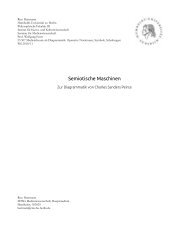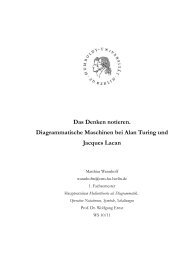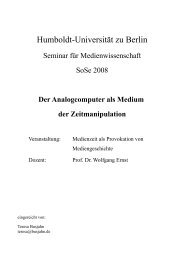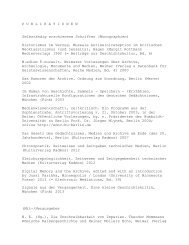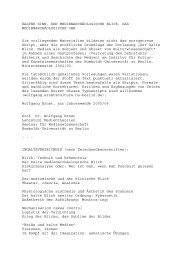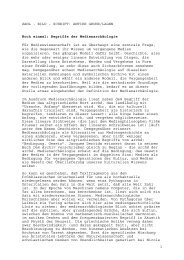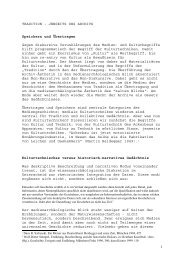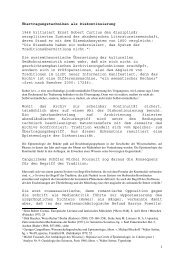Download - Medienwissenschaft
Download - Medienwissenschaft
Download - Medienwissenschaft
You also want an ePaper? Increase the reach of your titles
YUMPU automatically turns print PDFs into web optimized ePapers that Google loves.
Wolfgang Ernst<br />
THE CONCEPT OF THE ORIGINAL IN THE AGE OF<br />
THE W1RIÜAL WORLD<br />
Aura and Original (with, and beyond of, Walter Benjamin)<br />
According to Walter Benjamin, objects with a magnetic aura are precisely those that, in<br />
contrast to the ephemerality and repeatability of reproducible art, convey an aesthetics<br />
of singularity and permanency: as a unique "appearance of the distant, however near it<br />
may be." 1 Can Benjamin's aura, then, not be linked with the technologically repeatable video<br />
image? Let us consider an icon of video art, Nam June Paik's video installation<br />
Buddha (circa 1989. ZKM/Museum für Neue Kunst, Karlsruhe). Indeed, the video Buddha<br />
reminds us that from a cultural-aesthetical point of view, aura experiences can be incomparably<br />
authentic and irrefutable for the individual - "which brings them close to the<br />
mystic experiences of Christianity or Zen Buddhism." 2 Jochen Hörisch is also speaking of<br />
an aura literally coming forth ex negative referring to Walter Benjamin's work Kleine Geschichte<br />
der Photographie where he describes early portrait photographs: "There was an<br />
aura about them, a medium that, penetrating it, gave their gaze fullness and surety." 3<br />
Here, aura still describes the substance itself (in the medical and religious sense).<br />
In antiquity, medicine viewed the aura as indicating an imminent epileptic or hysteric attack:<br />
in the 19th century, the psychiatrist Hippolyte Baraduc tried, "through photographs,<br />
to objectify the aura of individuals which is invisible to the naked eye" - something of a<br />
scientific-positivist opposite to Benjamin's meaning regarding the loss of the aestheticmystic<br />
aura in the medium of photography, which he proclaims as a chance for the development<br />
of an antifascist aesthetics in film. 4<br />
Benjamin's theories have been refuted by the reality of Pop-Art (Andy Warhol's serial<br />
sculptures) and in particular by media art itself, where technology did not signal the<br />
exorcism of the aura, but an added dimension. The art critic Michael Glasmeier calls for<br />
a renewed study of Benjamin, "in which aura and reproduction will at last become secondary<br />
issues" 5 . The digital media are indeed diminishing the value of classic reproduction.<br />
The era when technological reproducibility was the foundation of the cultural economy<br />
is drawing to a close. An economy of mindfulness that values immediate perception<br />
rather than storage media will affect culture as a whole and hence the arts - and for<br />
the culture of the Occident this means a shift in emphasis from storage to transfer, from<br />
the savings account to the volatile share portfolio. It has been suggested that worldwide,<br />
fees for publications on the internet should no longer be based on the (actual) publication<br />
or programme (the original in television terms) but on the fact of its transmission,<br />
which need not be part of a framework. 6 The internet is not interested in archives<br />
(the build-up of storage as build-up of capital, the cultural prerequisite for claims of copyright),<br />
but in distribution.<br />
From the media change regarding the criteria material, space and time, Paul Valery<br />
- to whom Benjamin is referring 7 - has drawn his conclusions for "the whole of artistic<br />
-148-



